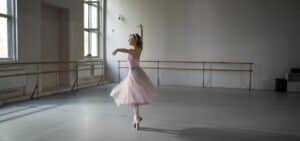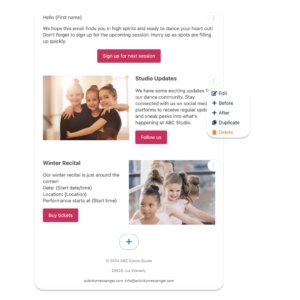
Starting a dance studio is a venture that combines an entrepreneurial spirit with a passion for teaching and dance. Below, we take a closer look at each step required to open a dance studio.
We’ll discuss:
Step 1: Business Plan
Step 2: Finding the Right Location
Step 3: Licenses and Insurance
Step 4: Attract and Hire Dance Teachers
Step 5: Market Your Dance School
Step 6: Use Technology for registrations, marketing and outreach
Step 7: Adapt and Monitor
Bonus: Other tools to help you open a dance studio
Author’s note: I’m Olivier and I share tips and tricks that I’ve learned over the last decade as the owner of a kids’s sports program. Today, as the co-founder of Activity Messenger, I help dance studios across the U.S. and Canada streamline their operations, improve how they communicate, and increase revenue.
A business plan is your roadmap to success when you open a dance studio. It should clearly define what you need to do to before and after the studio’s opening.

A decision that can greatly impact the success of your dance studio is choosing the perfect location. Here are some options to have in mind:
You can reduce your initial investment by partnering with community centers, local schools, or facilities that already have suitable areas or rooms to offer dance lessons. This allows you to take advantage of the existing audience and infrastructure of these venues, while avoiding the costs of maintaining your own studio. It’s important to negotiate terms that provide enough hours to meet the needs of your program.

Your own dance studio location requires a greater financial commitment, but offers you complete control over how the studio looks, functions and operates. This allows you to offer more classes and special events than you could in a shared space. Careful planning is essential, from securing funding to designing a user-friendly, code-compliant facility. With the freedom to customize everything from the flooring and mirrors to the sound system and lighting, you can make your dance studio stand out in a highly competitive marketplace.

Mobile Dance Classes allow you to offer your programs by traveling to your clients’ preferred locations, such as private homes or community centers. It minimizes overhead costs because there is no facility to maintain or rent. This model works well for clients who prefer the convenience of taking classes in their own space and provides flexibility in scheduling. However, you’ll need good logistical planning and marketing to ensure a steady flow of clients. Mobile dance classes are ideal for those looking to enter the market with a low initial investment.

A dance studio franchise is an great way to break into the dance industry. When evaluating franchise options, seek those that provide support, marketing assistance, operational training, and a well-established curriculum. This support can significantly ease the startup process and increase your chances of success. Brands such as DivaDance Dance Studio, Tippi Toes, Twinkle Star Dance, and KinderDance are known for their structured programs and strong community presence. Not only do these franchises streamline the start-up process with turnkey solutions, but they also provide ongoing support to franchisees to help them maintain high standards of safety and training.
Compliance is a critical element in establishing trust and credibility with your customers. Here are the key areas of compliance to consider when opening a dance studio:
To legally operate a dance studio, you must obtain the appropriate business license from your local city or county. Requirements may vary depending on where you live, so it’s important to check with local government websites or offices to find out the specific guidelines.
Maintaining strict health and safety standards is critical. Part of this is ensuring that the facility is safe and in compliance with all necessary health regulations. Emergency plans and first aid certifications are essential for handling any incidents.
To protect your business and provide peace of mind to your customers, having the right insurance coverage is essential. Liability insurance is coverage for injuries that may occur during classes at your studio. If you are the owner of your studio space, property insurance protects your business from damage such as fire or flood. Workers’ compensation insurance, required by law in many places if you have employees, covers medical expenses and lost wages for employees injured on the job. It protects both your employees and your business from unforeseen accidents.

Teachers are the cornerstone of your dance studio. They have a direct impact on the quality of your classes and the overall experience of your students. Here’s how to help make sure you have the right team:
It’s essential to ensure that all dance instructors are certified by reputable organizations. These certifications guarantee that the instructors are well-versed in the latest teaching methods and safety protocols. This not only adds credibility to your dance studio but also reassures parents that their children are learning from qualified and skilled professionals.


Conducting thorough background checks on your dance instructors is a non-negotiable. This step ensures that your staff are trustworthy and have no history that could jeopardize the safety of your dance community. Background checks should include criminal records, past employment verification, and references.
Using the insights from our blog post on hiring Gen Z employees, consider creating a dynamic work environment that appeals to younger dance instructors. They appreciates workplaces that are inclusive, tech-savvy, and socially responsible. Highlight opportunities for growth and learning, such as ongoing training and the potential for taking on more responsibility or advanced roles within your dance studio. This approach will not only attract talented instructors. It will also foster a motivated and engaged team.
To retain your instructors, you should create a culture of feedback and recognition. Keeping Gen-Z employees engaged and happy through regular check-ins, performance reviews and open channels of communication is important. Younger staff also value flexibility and autonomy. Offering flexible scheduling and supporting their need for work-life balance can be critical to retention.
Integrating these strategies creates an environment that attracts and retains top performers. This ensures a higher standard of dance instruction which leads to a better overall customer experience.
Effectively marketing your dance studio requires a omnichannel approach to reaching and converting prospects. By combining digital and traditional marketing strategies, you can build awareness to increase enrollment.
Here are some key marketing ideas for dance studios:

By implementing these marketing strategies, you can effectively reach and convert prospects, building a strong and loyal dance community.
Read: More: 14 marketing ideas to grow your Dance Studio
Business efficiency and the overall customer experience can be greatly improved by incorporating technology into your dance studio. An online platform such as Activity Messenger offers a variety of features to help streamline your operations:
Setting up registration forms for dance classes is easy with Activity Messenger. The intuitive interface speeds up enrollment and reduces administrative tasks by making it easier for parents to register their children.

Keep parents up to date on their child’s progress with digital progress reports and online dance report cards. This feature provides real-time updates on student progress and is more accessible and environmentally friendly than traditional paper reports.

Activity Messenger automates and personalizes communications with integrated email marketing tools. Manage all your email marketing and SMS needs, from sending promotional offers and class reminders to sharing educational content. You can personalize your messages with mailmerge to increase the relevance of your outreach for each individual.
Use Activity Messenger to move your dance class liability waivers online. Reduce paperwork, minimize errors, and securely store sensitive information by adding these waivers to your registration forms. This streamlined process speeds up registration and improves the overall customer experience by making it hassle-free.

The need for a modern dance studio management software becomes critical as your dance studio grows. Activity Messenger provides solutions for scheduling, billing and managing clients. The platform provides a single view of all operational data for better tracking, analysis, and decision-making. You can start with a simple registration form when you open your studio and scale up with sophisticated registration software as you expand.
Here is a comparison of the top 12 dance studio management softwares on the market.
By starting with an easy-to-use technology solution like Activity Messenger, new dance studios can manage their operations more efficiently offer a great customer experience from the start of the registration process. The ability to grow and scale while keeping administrative tasks manageable can help you open a dance studio and then grow to its full potential.
The success and growth of your dance studio depends on responding to customer needs and market dynamics. Here’s how you can effectively manage these aspects of your business:
Actively collect and analyze feedback from your customers. Use this data to refine your teaching methods and overall customer experience by making it easy for parents and students to provide feedback with end-of-session reminders. You can also gain valuable insights by engaging directly with customers through feedback sessions or parent meetings.
Pay close attention to your dance studio financials. Review your income statements, balance sheets and cash flow statements regularly. This will help you understand your financial health. Use this information to identify areas where costs can be reduced or where investments are yielding a positive return on investment. To improve your bottom line, adjust your pricing structure, explore new revenue streams (such as advanced classes or seasonal camps), and cut unnecessary expenses.
Stay up to date on the latest developments in dance education, safety protocols, and improvements in customer service. Attend industry conferences, listen to industry podcasts and participate in dance forums and online communities. Also, keep an eye on your competitors to see what they are doing differently or new classes they might be offering.
Activity Messenger can help you open your dance school or studio. It provides all the tools you need to succeed and grow your new dance school.
Attendance Tracking for Dance
Best Dance Quotes to inspire
End of session reminders
Waitlist Management
How to collect more online reviews
How to us AI for dance Studios
Tools to grow your dance studio
7 best dance studio management software
If you would like to learn more about Activity Messenger, book a demo with one our experts.